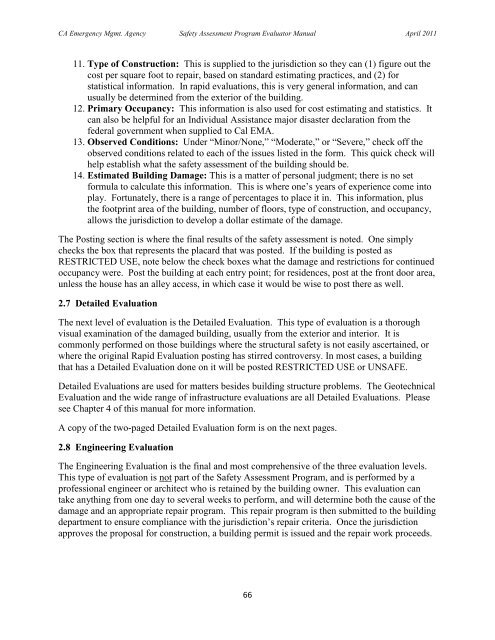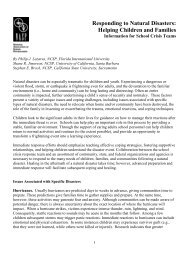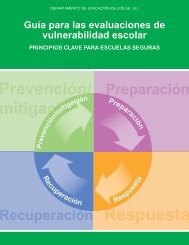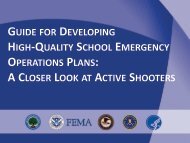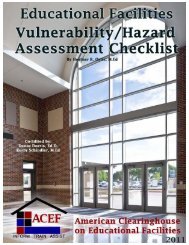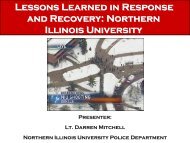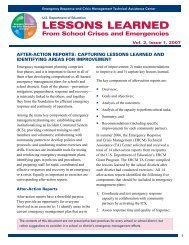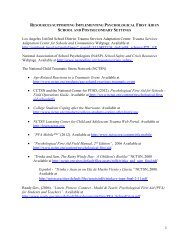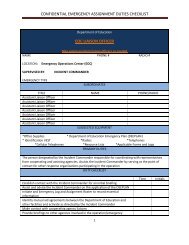Safety Assessment Program Evaluator Student Manual
Safety Assessment Program Evaluator Student Manual
Safety Assessment Program Evaluator Student Manual
Create successful ePaper yourself
Turn your PDF publications into a flip-book with our unique Google optimized e-Paper software.
CA Emergency Mgmt. Agency <strong>Safety</strong> <strong>Assessment</strong> <strong>Program</strong> <strong>Evaluator</strong> <strong>Manual</strong> April 201111. Type of Construction: This is supplied to the jurisdiction so they can (1) figure out thecost per square foot to repair, based on standard estimating practices, and (2) forstatistical information. In rapid evaluations, this is very general information, and canusually be determined from the exterior of the building.12. Primary Occupancy: This information is also used for cost estimating and statistics. Itcan also be helpful for an Individual Assistance major disaster declaration from thefederal government when supplied to Cal EMA.13. Observed Conditions: Under “Minor/None,” “Moderate,” or “Severe,” check off theobserved conditions related to each of the issues listed in the form. This quick check willhelp establish what the safety assessment of the building should be.14. Estimated Building Damage: This is a matter of personal judgment; there is no setformula to calculate this information. This is where one‟s years of experience come intoplay. Fortunately, there is a range of percentages to place it in. This information, plusthe footprint area of the building, number of floors, type of construction, and occupancy,allows the jurisdiction to develop a dollar estimate of the damage.The Posting section is where the final results of the safety assessment is noted. One simplychecks the box that represents the placard that was posted. If the building is posted asRESTRICTED USE, note below the check boxes what the damage and restrictions for continuedoccupancy were. Post the building at each entry point; for residences, post at the front door area,unless the house has an alley access, in which case it would be wise to post there as well.2.7 Detailed EvaluationThe next level of evaluation is the Detailed Evaluation. This type of evaluation is a thoroughvisual examination of the damaged building, usually from the exterior and interior. It iscommonly performed on those buildings where the structural safety is not easily ascertained, orwhere the original Rapid Evaluation posting has stirred controversy. In most cases, a buildingthat has a Detailed Evaluation done on it will be posted RESTRICTED USE or UNSAFE.Detailed Evaluations are used for matters besides building structure problems. The GeotechnicalEvaluation and the wide range of infrastructure evaluations are all Detailed Evaluations. Pleasesee Chapter 4 of this manual for more information.A copy of the two-paged Detailed Evaluation form is on the next pages.2.8 Engineering EvaluationThe Engineering Evaluation is the final and most comprehensive of the three evaluation levels.This type of evaluation is not part of the <strong>Safety</strong> <strong>Assessment</strong> <strong>Program</strong>, and is performed by aprofessional engineer or architect who is retained by the building owner. This evaluation cantake anything from one day to several weeks to perform, and will determine both the cause of thedamage and an appropriate repair program. This repair program is then submitted to the buildingdepartment to ensure compliance with the jurisdiction‟s repair criteria. Once the jurisdictionapproves the proposal for construction, a building permit is issued and the repair work proceeds.66


